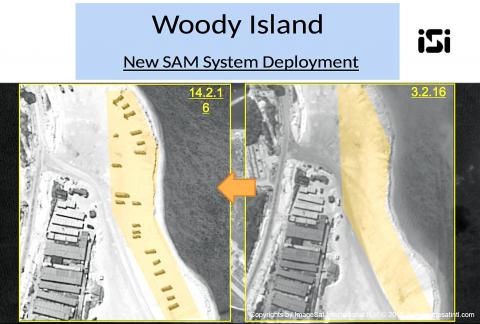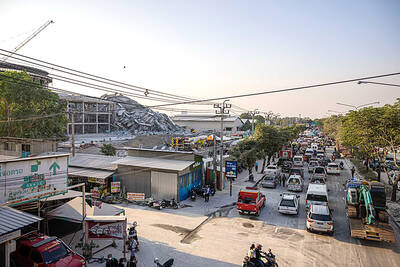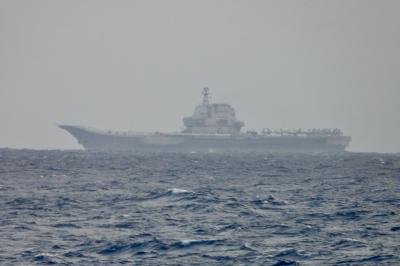China confirmed that it has weapons on a disputed island in the South China Sea, state media said yesterday, as US Secretary of State John Kerry slammed Beijing for “militarization” of the strategically vital region.
The US broadcaster Fox News on Tuesday reported that a privately owned satellite company had provided images that appeared to show two batteries of eight surface-to-air missile launchers and a radar system had been installed on Woody Island (Yongxing Island, 永興島) — one of the Paracel Islands (Xisha Islands, 西沙群島) — earlier this month.
Pentagon officials say the pictures are authentic, and Ministry of National Defense spokesman Major General David Lo (羅紹和) on Wednesday said that Taipei is closely monitoring developments.

Photo: EPA
Taiwan, China and Vietnam claim all or part of the Paracel Islands.
The Chinese Ministry of National Defense yesterday confirmed that “China has deployed weapons on the island for a long time,” reported the Global Times newspaper, which has close ties to the Chinese Communist Party.
It did not specify what weapons were on the island.
However, it attempted to downplay the deployment, saying recent reports were an example of Western media playing “the same old tune” about a “China threat,” the newspaper cited the ministry’s news office as saying.
“China has the fair and legal right to deploy defense facilities within the boundaries of its own territory,” the report added.
Tensions in the sea — through which one-third of the world’s oil passes — have mounted in recent months since China transformed contested reefs in the Spratly Islands (Nansha Islands, 南沙群島) further south into artificial islands capable of supporting military facilities.
Washington says Beijing’s actions threaten free passage in a strategically vital area and has sent warships close to the disputed islands to assert freedom of navigation, raising fears of escalation.
The US is planning “very serious conversations” with China about the anti-aircraft missiles Beijing is believed to have deployed on the island, Kerry said on Wednesday.
Answering questions from reporters in Washington, Kerry said there was “every evidence” that China was increasing militarization in the South China Sea.
He said that Chinese President Xi Jinping (習近平) stood in the Rose Garden of the White House last year and promised that there would be no militarization of the South China Sea.
“We have said repeatedly with respect to China that the standard that should be applied to all countries with respect to the South China Sea is no militarization,” Kerry said.
“We had these conversations with the Chinese and I’m confident that over the next days, we will have further very serious conversations on this,” Kerry said.
The top US diplomat expressed hope that Beijing would work to resolve the maritime disputes “not through unilateral action, not through force, not through militarization, but through diplomacy and by working with other countries and claimants.”
Meanwhile, Beijing has insisted it has the right to build “self-defense” systems in the region.
An editorial published yesterday in the Global Times said that the US has “injected the most military elements in the region.”
If China has in fact placed surface-to-air missiles on the island, they might make “jet fighters from the US ... feel uneasy when making provocative flights in the region. To us, that’s a proper result,” the editorial said.

AIR SUPPORT: The Ministry of National Defense thanked the US for the delivery, adding that it was an indicator of the White House’s commitment to the Taiwan Relations Act Deputy Minister of National Defense Po Horng-huei (柏鴻輝) and Representative to the US Alexander Yui on Friday attended a delivery ceremony for the first of Taiwan’s long-awaited 66 F-16C/D Block 70 jets at a Lockheed Martin Corp factory in Greenville, South Carolina. “We are so proud to be the global home of the F-16 and to support Taiwan’s air defense capabilities,” US Representative William Timmons wrote on X, alongside a photograph of Taiwanese and US officials at the event. The F-16C/D Block 70 jets Taiwan ordered have the same capabilities as aircraft that had been upgraded to F-16Vs. The batch of Lockheed Martin

GRIDLOCK: The National Fire Agency’s Special Search and Rescue team is on standby to travel to the countries to help out with the rescue effort A powerful earthquake rocked Myanmar and neighboring Thailand yesterday, killing at least three people in Bangkok and burying dozens when a high-rise building under construction collapsed. Footage shared on social media from Myanmar’s second-largest city showed widespread destruction, raising fears that many were trapped under the rubble or killed. The magnitude 7.7 earthquake, with an epicenter near Mandalay in Myanmar, struck at midday and was followed by a strong magnitude 6.4 aftershock. The extent of death, injury and destruction — especially in Myanmar, which is embroiled in a civil war and where information is tightly controlled at the best of times —

China's military today said it began joint army, navy and rocket force exercises around Taiwan to "serve as a stern warning and powerful deterrent against Taiwanese independence," calling President William Lai (賴清德) a "parasite." The exercises come after Lai called Beijing a "foreign hostile force" last month. More than 10 Chinese military ships approached close to Taiwan's 24 nautical mile (44.4km) contiguous zone this morning and Taiwan sent its own warships to respond, two senior Taiwanese officials said. Taiwan has not yet detected any live fire by the Chinese military so far, one of the officials said. The drills took place after US Secretary

THUGGISH BEHAVIOR: Encouraging people to report independence supporters is another intimidation tactic that threatens cross-strait peace, the state department said China setting up an online system for reporting “Taiwanese independence” advocates is an “irresponsible and reprehensible” act, a US government spokesperson said on Friday. “China’s call for private individuals to report on alleged ‘persecution or suppression’ by supposed ‘Taiwan independence henchmen and accomplices’ is irresponsible and reprehensible,” an unnamed US Department of State spokesperson told the Central News Agency in an e-mail. The move is part of Beijing’s “intimidation campaign” against Taiwan and its supporters, and is “threatening free speech around the world, destabilizing the Indo-Pacific region, and deliberately eroding the cross-strait status quo,” the spokesperson said. The Chinese Communist Party’s “threats